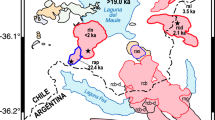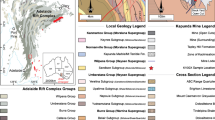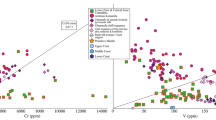Abstract
Fe–Ni sulfides and metal–sulfide segregations in shock melt veins (pallasite Seymchan) and in a nodule (iron meteorite Dronino) were studied by scanning electron microscopy (SEM). It was found that sulfide assemblages contain not only troilite (FeS) but also Fe–Ni sulfides, namely pentlandite (FexNi1–x)9S8, and heazlewoodite Ni3S2, which form rims around primary troilite. The metal–sulfide segregations, in contrast to sulfide ones, consist of troilite, pentlandite and metallic nickel and have an unusual reticulate texture. The reticulate texture consists of isolated troilite grains surrounded by fibrous intergrowths of troilite, pentlandite, and metallic nickel. The Fe–Ni sulfides and metal–sulfide assemblages correspond to the solid–phase equilibrium in the Fe–Ni–S system in the low-temperature region (T < 875°C). Meanwhile, the shock melt veins in Seymchan demonstrate a liquid immiscibility of phosphate and metal–sulfide melts, which indicates the local shock melting of the vein material at temperatures T > 1500°C. In accordance with the FeNi–FeS phase diagram, the solidification of metal–sulfide melts begins at a temperature of 988°C via the formation of FeNi + FeS eutectic intergrowths. The disagreement of the observed phase composition and microtexture of metal–sulfide intergrowths in Seymchan and Dronino with those of eutectic FeNi + FeS intergrowths indicates the modification of the former metal–sulfide eutectic microtexture with the appearance of a low-temperature association FeS + pentlandite (FexNi1 – x)9S8 + Ni. On the basis of the data obtained, it was proposed that troilite + pentlandite + heazlewoodite and troilite + pentlandite + Ni(metal) assemblages in Seymchan and Dronino meteorites were formed due to long-term low-temperature interaction between coexisting FeNi metal and troilite, which proceeds with participation of groundwater on the Earth surface. Electrochemical reactions between meteorite material and partially dissociated aqueous solutions circulating along fractures are suggested to explain the formation of secondary sulfide phases, pentlandite (FexNi1 – x)9S8 and heazlewoodite Ni3S2, in pallasites and iron meteorites. The model of the supergene origin of the troilite + pentlandite + heazlewoodite and troilite + pentlandite + Ni (metal) associations is consistent with the intense corrosion of the Seymchan and Dronino meteorites, which is expressed by the extensive development of Fe-oxide/Fe-hydroxide rims and especially by the appearance of secondary hydrated minerals of supergene origin in Dronino.









Similar content being viewed by others
Notes
English abbreviation of back-scattered electron (BSE) images.
REFERENCES
A. W. Bevan, P. J. Downes, and M. Thompson, “Little Minnie Greek, an L4(S2) ordinary chondritic meteorite from Western Australia,” J. Roy. Soc. Western Australia 84, 149–152 (2001).
J. S. Boesenberg, J. S. Delaney, and R. H. Hewins, “A petrological and chemical re-examination of main group pallasite formation,” Geochim. Cosmochim. Acta 89, 134–158 (2012).
A. J. Brearly, “The action of water,” In: Meteorites and the Early Solar System II, Ed. by D. S. Lauretta and H. Y. McSween (Univ. of Arizona Press, Tucson, 2006), pp. 584–624.
S. N. Britvin, S. V. Krivovichev, and T. Armbruster, “Ferromerrillite, Ca9NaFe2+(PO4)7, a new mineral from the Martian meteorites, and some insights into merrillite–tuite transformation in shergottites,” Eur. J. Mineral. 28, 125–136 (2016).
E. V. Brusnitsyna, R. F. Muftakheltdinova, G. A. Yakovlev, and V. I. Grokhovsky, “The octahedrite and pallasite parts metallographic comparison of the Seymchan meteorite,” 82nd Annual Meeting of Meteoritic Society 2019, LPI Contrib., No 2157, #6481 (2019).
V. F. Buchwald, “The mineralogy of iron meteorites,” Philos. Trans. R. Soc. A. 286 (1336), 453–491 (1977).
E. S. Bullock, M. Grady, M. Gounelle, and S. S. Russell, “Fe–Ni sulphides as indicators of alteration in CM chondrites, 38th LPSC (Houston, Texas, 2007), 2057.pdf
L. Chudinovskikh and R. Boehler, “Eutectic melting in the system Fe–S to 44 GPa,” Earth Planet Sci Lett. 257, 97–103 (2007).
N. V. Chukanov, I. V. Pekov, L. A. Levitskaya, and A. E. Zadov, “Droninoite Mg3Fe3+Cl(OH)8·2H2O—a new mineral of the hydrotalcite group from the weathered Dronino meteorite,” Zap. Ross. Mineral. O-va 137 (6), 38–46 (2008).
Z. N. Fedorova and E. F. Sinyakova, “Experimental study of physicochemical conditions of pentlandite formation,” Geol. Geofiz. 34, 24–92 (1993).
N. A. Fowler-Gerace, Textural and Geochemical Investigation of Springwater Pallasite Olivine, Thesis of Master of Applied Science (Univ. of Toronto, 2014).
N. A. Fowler-Gerace, K. T. Tait, D. E. Moser, I. Barker, and B. Y. Tian, “Aligned olivine in the Springwater pallasite,” Meteorit. Planet. Sci. 51, 1125–1135 (2016).
J. Fritz, A. Greshake, and V. F. Fernandes, “Revising the shock classification of meteorites,” Meteorit. Planet. Sci. 52, 1216–1232 (2017).
V. I. Grokhovsky, V. F. Ustyugov, D. D. Badyukov, and M. A. Nazarov, “Dronino: An ancient iron meteorite shower in Russia.,” In: 36th LPSC, abstract #1692 (2005).
V. I. Grokhovsky, M. I. Oshtrakh, O. B. Milder, and V. A. Semionkin, “Mӧssbauer spectroscopy of iron meteorite Dronino and products of its corrosion,” Hyperfine Interactions 166, 671–677 (2006).
C. Hamann, L. Hecht, M. Ebert, and R. Wirth, “Chemical projectile-target interaction and liquid immiscibility in impact glass from the Wabar craters, Saudi Arabia,” Geochim. Cosmochim. Acta 121, 291–310 (2013).
C. Hamann, A. Fazio, M. Ebert, L. Hecht, R. Wirth, L. Folco, A. Deutsch, and W. U. Reinold, “Silicate liquid immiscibility in impact melts,” Meteorit. Planet. Sci. 53, 1594–1632 (2018).
D. Harries and F. Langenhorst, “The nanoscale mineralogy of Fe,Ni sulfides in pristine and metamorphosed CM and CM/CI-like chondrites: Tapping a petrogenetic record,” Meteorit. Planet. Sci. 48, 879–903 (2013).
D. Harries and M. E. Zolensky, “Mineralogy of iron sulfides in CM1 and CI1 lithologies of the Kaidun breccia: Records of extreme to intense hydrothermal alteration,” Meteorit. Planet. Sci. 51, 1096–1109 (2016).
N. R. Khisina, D. D. Badyukov, and R. Wirth, “Microstructure, nanomineralogy and local chemistry of cryptocrystalline cosmic spherules. Geochem. Int. 54(1), 68–77 (2016).
N. R. Khisina, R. Wirth, and A. A. Abdrakhimov, “Liquid immiscibility in regions of localized shock-induced melting in the Elga meteorite,” Geochem. Int. 57, 903–911 (2019).
N. R. Khisina, D. D. Badyukov, V. G. Senin, and A. A. Burmistrov, “Evidence for local shock melting in Seymchan meteorite,” Geochem. Int. 58 (9), 994–1003 (2020).
S. E. Kichanov, D. P. Kozlenko, E. V. Lukin, A. V. Rutkauska, E. A. Krasavin, A. Y. Rozanov, et al., “A neutron tomography study of the Seymchan pallasite,” Meteorit. Planet. Sci. 53 (10), 2155–2164 (2018).
A. Kitakaze, T. Machida, and R. Komatsu, “Phase relations in the Fe–Ni–S system from 875 to 650°C,” Can. Mineral. 54, 1175–1186 (2016).
V. I. Kosyakov, E. F. Sinyakova, and V. A. Shestakov, “Dependence of sulfur fugacity on the composition of phase associations in the Fe–FeS–NiS–Ni system at 873 K,” Geochem. Int. 41 (7), 660–669 (2003).
M. D. LeClerc, Cosmochemistry of Iron Meteorites; Trace Element Composition of Metal and Sulfide Phases, PhD Thesis, (Earth Science and Engineering, Imperial College London, 2015). K. Litasov, “Detailed mineralogy and trace element chemistry of Dronino iron meteorite: a pentlandite and heazlewoodite issue,” 52nd Lunar and Planetary Sci. Conf., LPI Contrib. No.1445, 2548.pdf (2021).
D. Mittlefehldt, T. McCoy, C. Goodrich, and A. Kracher, “Non-Chondritic Meteorites from Asteroidal Bodies, Planetary Materials. Ed by J. J. Papike, Rev. Mineral. Geochem. 36 (1), 4-01–4-198 (1998).
M. I. Oshtrakh, V. I. Grokhovsky, E. V. Petrova, M. Yu. Larionov, M. V. Goryunov, and V. A. Semionkin, “Mössbauer spectroscopy with a high velocity resolution applied for the study of meteoritic iron-bearing minerals,” J. Mol. Struct., No. 1044, 268–278 (2013).
M. L. Oshtrakh, G. A. Yakovlev, V. I. Grokhovsky, and V. A. Semionkin, “Re-examination of Dronino iron meteorite and its weathering products using Mossbauer spectroscopy with a high velocity resolution,” Hyperfine Interactions 237, 42 (2016).
I. V. Pekov, N. Perchiazzi, S. Merlino, V. N. Kalachev, M. Mellini, and A. E. Zadov, “Chukanovite, Fe2(CO3)(OH)3Cl a new mineral from the weathering iron meteorite Dronino,” Eur. J. Mineral. 19, 891–898 (2007).
E. V. Petrova, A. A. Maksimova, A. V. Chukin, and M. I. Oshtrakh, “Variations in olivine extracted from two different fragments of Seymchan main group pallasite, 81st Annual Meeting of the Meteoritical Society 2018, LPI Contrib. No. 2067, 6094.pdf (2019).
G. S. Ripp, V. V. Sharygin, I. A. Izbrodin, A. L. Ragozin, and E. A. Khromova, “Mineralogy and geochemistry of iron meteorite Yakut (IIAB), Buryatiya,” 200 th Annual Conference of the Russian Mineralogical Society, St. Petersburg, Russia, 2017 (St. Petersburg, 207), Vol. 2, pp. 311–313.
A. E. Rubin, “Mineralogy of meteorite groups,” Meteorit. Planet. Sci. 32, 231–247 (1997).
B. Ryzhenko and G. C. Kennedy, “The effect of pressure on the eutectic in the system Fe–FeS,” Am. J. Sci. 273, 803–810 (1973).
D. L. Schrader and T. J. Zega, “Petrographic and compositional indicators of formation and alteration conditions from LL chondrite sulfides,” Geochim. Cosmochim. Acta 264, 165–179 (2019).
D. L. Schrader, J. Davidson, and T. J. McCoy, “Widespread evidence for high temperature formation of pentlandite in chondrites,” Geochim. Cosmochim. Acta 189, 359–376 (2016).
V. P. Semenenko and C. Perron, “Shock–melted material in the Krymka LL3.1 chondrite: Behavior of the opaque minerals,” Meteorit. Planet. Sci. 40, 173 (2005).
R. Sharma and Y. Chang, “Thermodynamics and phase relationships of transition metal-sulfur systems: Part III. Thermodynamic properties of the Fe–S liquid phase and the calculation of the Fe–S phase diagram,” Metall. Mater. Trans. Section B. 10, 103–108 (1979).
T. G. Sharp and P. S. DeCarli, “Shock effects in meteorites,” In Meteorites and the Early Solar System II, Ed. by D. S. Lauretta and H. Y. McSween (Univ. Arizona Press, 2006), pp. 653–677.
V. V. Sharygin, “Mineralogy of silicate–natrophosphate immiscible inclusion in Elga IIE iron meteorite,” Minerals 10, 437–466 (2020).
A. J. Stewart, M. W. Schmidt, W. van Westrenen, and C. Liebske, “Mars: a new core crystallization regime,” Science 316, 1323–1325 (2007).
D. Stoffler, A. Bischoff, V. Buchwald, and A. E. Rubin, “Shock effects in meteorites,” In Meteorites and the Early Solar System, Ed. by J. F. Kerridge and M. S. Matthews (Univ. of Arizona, Tuscon, 1988), pp. 165–202.
A. Sugaki and A. K. Kitakaze, “High form of pentlandite and its thermal stability,” Am. Mineral. 83, 133–140 (1998).
A. V. Svetlov, D. V. Makarov, S. S. Potapov, D. A. Nekipelov, S. G. Seleznev, and V. A. Masloboev, “Study of leaching of disseminated copper–nickel ores during their interaction with mine waters,” Vestn. MGTU, no. 1–2, 165176 (2017).
S. N. Teplyakova, C. A. Lorenz, M. A. Ivanova, N. N. Kononkova, M. O. Anosova, K. M. Ryazantsev, and Yu. A. Kostitsin, “Mineralogy of silicate inclusions in the Elga IIE iron meteorite,” Geochem. Int. 56 (1), 1–23 (2018).
A. G. Tomkins, R. F. Weinberg, B. F. Schaefer, and A. Langendam, “Disequilibrium melting and melt migration driven byimpacts: implications for rapid planetesimal core formation,” Geochim. Cosmochim. Acta 100, 4–59 (2013).
D. Van Niekerk, R. C. Greenwood, I. A. Franchi, E. R. D. Scott, and K. Keil, “Seymchan: a main group pallasite–not an iron meteorite,” Meteorit. Planet Sci. 42, A154 (2007).
N. Van Roosbroek, C. Hamann, S. McKibbin, A. Greshake, R. Wirth, L. Pittarello, L. Hecht, P. Claeys, and V. Debaille, “Immiscible silicate liquids and phosphoran olivine in Netschaevo IIE silicate: analogue for planetesimal core-mantle boundaries,” Geochim. Cosmochim. Acta 197, 378–395 (2017).
X. Xie and M. Chen, “Yanzhuang meteorite: mineralogy and shock metamorphism, (Springer, Southern Publishing and Media Guangdong Science & Technology Press, 2020).
X. Xie, M. Chen, S. Zhai, and F. Wang, “Eutectic metal + troilite + Fe–Mn–Na phosphate + Al-free chromite assemblage in shock-produced chondritic melt of the Yanzhuang chondrite,” Meteorit. Planet. Sci. 49 (12), 2290–2304 (2014).
J. Yang, J. I. Goldstein, and E. R. D. Scott, “Main-group pallasites: Thermal history, relationship to IIIAB irons, and origin,” Geochim. Cosmochim. Acta 74, 4471–4492 (2010).
M. E. Zolensky and L. Le, “Iron–nickel sulfide compositional ranges in CM chondrites: No simple plan,” 34th LPSC, abstract #1235 (2003).
ACKNOWLEDGMENTS
We are grateful to E.M. Spiridonov for valuable comments during manuscript preparation. V.G. Senin is thanked for help in microprobe measurements. Reviewers S.N. Teplyakova and V.I. Grokhovsky are thanked for useful comments.
Funding
This work was performed in the framework of the state task of the Ministry of Higher Education and Science.
Author information
Authors and Affiliations
Corresponding authors
Ethics declarations
The authors declare that they have no conflicts of interest.
Additional information
Translated by M. Bogina
Rights and permissions
About this article
Cite this article
Khisina, N.R., Badyukov, D.D. Conditions of Formation of the Pentlandite (Fe,Ni1 – x)9S8 and Heazlewoodite Ni3S2 in the Pallasite Seymchan and Dronino Iron Meteorite. Geochem. Int. 60, 1207–1220 (2022). https://doi.org/10.1134/S0016702922120023
Received:
Revised:
Accepted:
Published:
Issue Date:
DOI: https://doi.org/10.1134/S0016702922120023




